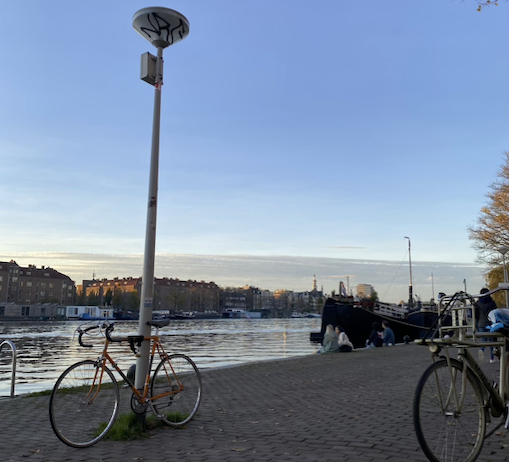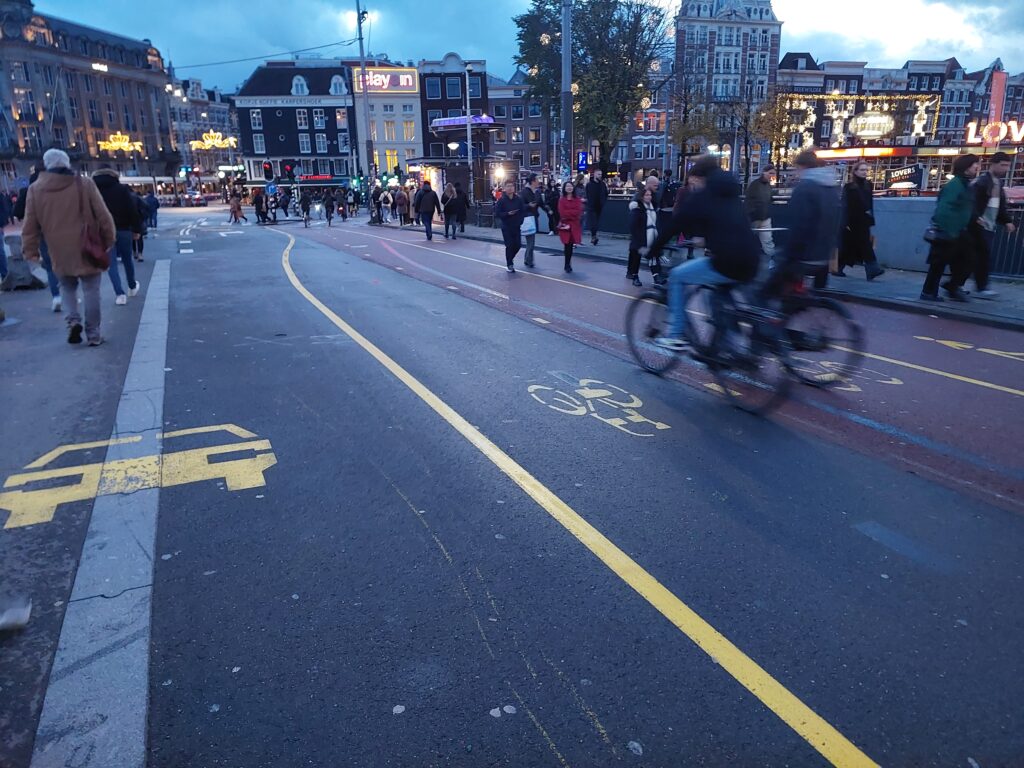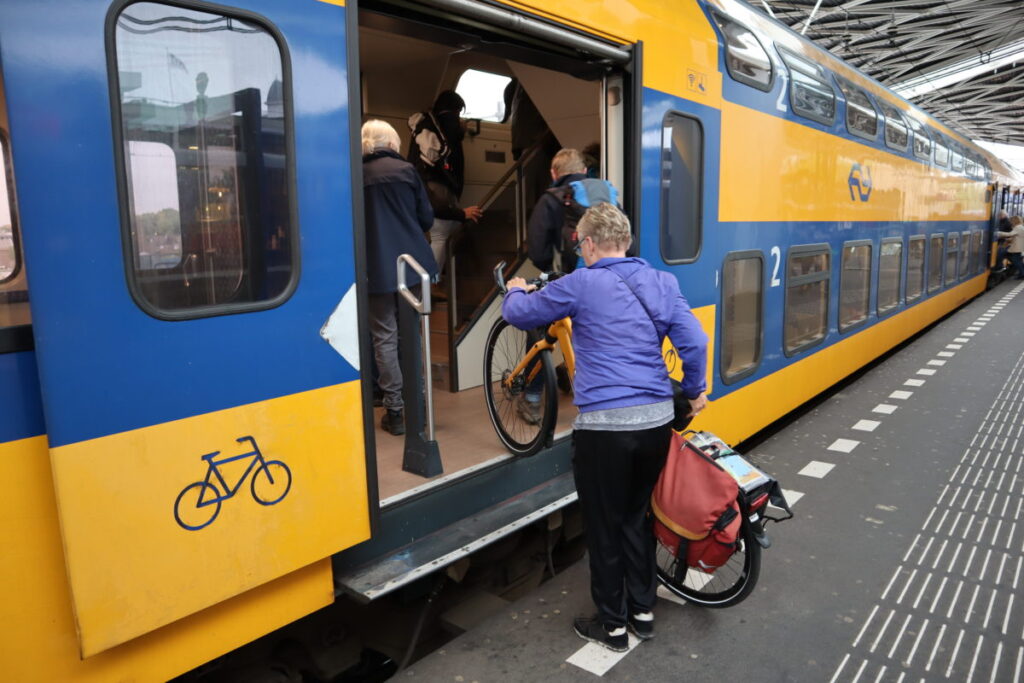Kevin H. Posey | LinkedIn
Selected final essay, published 28 April 2020
Writer/consultant on transportation and sustainability issues in Atlanta, Georgia and served on various transportation boards and commissions in the Washington, D.C. region.
Unraveling the Cycling City MOOC on Coursera
The change from a culture that is car-centric to one that is bike-friendly isn’t as simple as flipping a light switch. It is an evolutionary process, as is the case with most significant societal changes. So is it reasonable to expect countries that are just beginning this evolution, such as the United States, to graft solutions from far more advanced societies, like The Netherlands, onto their transport systems? Or, would it better to look at the Dutch evolutionary process for a more attainable, intermediate step?
The Netherlands hasn’t always had the national “habitus” that included using bikes to get around (Kuipers, 2013), Bike infrastructure in the Netherlands in the early 20th century often consisted of narrow lanes with poor paving, a lack of connectivity, and complete absence at many intersections (Waagenbuur, 2012). That ought to sound familiar to US readers, who are all too familiar with such conditions.
Even so, that was better than what was to come. Just prior to World War II, Dutch planners engaged in self-criticism by stating that their infrastructure was lacking, as exemplified by the way the number of cars in use “lagged behind” the United States (Oldenziel, 2011). Crashes and congestion issues at the time were blamed on cyclists, who were viewed as being of a lower socioeconomic status and in need of control. It is therefore unsurprising that the period between the war and the oil crisis was a time when “cyclists were under severe threat of being expelled from Dutch cities by the growing number of cars,” thanks to the hostility of traffic engineers who had supplanted the grassroots organizations that had advocated for better roads to begin with (Van der Zee, 2015).

Those grassroots interests would stage a comeback via the Stop de Kindermoord campaign in the early 1970s which, combined with the difficulties brought on by the oil crisis, would reanimate the Dutch love of bikes.That evolutionary process continues today, as cycling rises with the growing concentration of the population in urban centers (Harms, 2014). With that rise comes severe strain on the networks of urban centers, necessitating significant changes to existing bike infrastructure. In Amsterdam, a pilot project on Sarphatistraat was undertaken to test a cycle street that would not only be fast and comfortable, “but also caters for slower, more sociable cyclists to cycle alongside each other and have a chat (Aluvihare, 2018).” This is clearly a more elevated discussion than what is typical in the US, where mere proposal of an unprotected bike lane can generate national-level media pushback (Buckley, 2013).

Increasing urbanization poses challenges for bike infrastructure in the US, but not at quite the same level. Consider the Old Fourth Ward neighborhood of Atlanta, which is home to both the Atlanta Beltline and a booming real estate market (Posey, 2019). The Beltline is a former railroad circuit that has been partially converted to a multiuser path that, thanks to large developments adjacent and nearby, is overcrowded to the point where cycling is often difficult and unsafe. This could be alleviated with a separate, parallel path on the right-of-way reserved for a planned tram line. However, note that this entire issue is limited to a single corridor. Connecting paths to the Beltline are few. Contrast that to Dutch planning issues, which focus on how best to accommodate numbers of cyclists so big that they can be best conceptualized as a swarm or flock of starlings (te Brommelstroet, 2014).
Perhaps the gap in the level of discussion between The Netherlands and the United States is best exemplified by Samuel Nello-Deakin, who argues that “…calls for a ‘fair’ distribution of road space ultimately rely on a simplistic logic which is inherently problematic (Nello-Deakin, 2019).” This was in response to Mikael Colville-Andersen’s well-circulated blog post calling for exactly that (Colville-Andersen, 2019). Nello-Deakin, who focuses on Amsterdam alone, proposes “…measuring the distribution of street speed limits at a city-wide or neighborhood level might potentially offer a simple but useful measure of equity between different forms of transport: a priori, a given area is more equitable the lower its street speed limits are.”
Unfortunately, this is not practical in the United States. It is not uncommon for streets to receive a lower speed limit in response to citizen complaints, while the road design remains conducive to speeding by motorists. In Alexandria, Virginia, Seminary Road was recently narrowed from four lanes for motorists to two, with the addition of two bike lanes, after a speed limit reduction combined with strict enforcement failed to create a safer environment for cyclists (Sullivan, 2019). Without engineering changes and a fair distribution of road space, cycling was viewed to be difficult and unsafe. The result is more in line with Colville-Andersen’s take than Nello-Deakin’s. To be fair, the latter author acknowledges the need for cross-national study, but the lack of any severely reduces the utility of his analysis.

Are there any countries that might stand in for an earlier stage in the Dutch evolution that US planners and politicians could look to? If Germany, a country with varied topography, were used as the infrastructure example, it might neutralize the common refrain that the Dutch only bike because the country is so flat (Brailsford, 2015). Another possible candidate is Denmark, which has a lower mode share for bikes, but employs separated facilities that seem to be key in providing cyclists with the comfort they require (Pucher, 2008). Certainly, the analysis provided by Colville-Andersen of Copenhagenize would indicate some cross-cultural awareness that could translate into helpful change in the US.
The Dutch have the finest cycling infrastructure in the world, but it is both a blessing and a burden. The blessing derives from its utility as an aspirational goal for countries with a less developed transportation infrastructure. The burden is the gulf in understanding between those countries and The Netherlands. If Dutch advisors remember their history and pull from it to transition car-centric societies towards micromobility solutions like the bicycle, they will have a more productive impact than they do today.
Resources:
- Aluvihare, R., Linders, S., & Vernooij, Kees, Cycle-friendly Design in the Compact City (Plan Amsterdam, 2018), pp.14-29.
- Buckley, F. H., We Have Not Yet Begun to Fight the Bike Lanes (The Wall Street Journal, 2013).Colville-Anderen, M., The Arrogance of Space (Medium, 2019).
- Harms, L., Bertolini, L., & te Brommelstroet, M., Spatial and Social Variations in Cycling Patterns in a Mature Cycling Country Exploring Differences and Trends (Journal of Transport and Health, 1(4), 2014), pp. 232-242.
- Kuipers, Giseline, The Rise of National Habitus: Dutch Cycling Culture and the Shaping of National Similarity (European Journal of Social Theory 16 (1), 2013), pp.17-35.Nello-Deakin, S., Is There Such a Thing as a “Fair” Distribution of Road Space? (Journal of Urban Design, 2019).
- Oldenziel, R., & de la Bruheze, A.A., Contested Spaces: Bicycle Lanes in Urban Europe, 1900-1995 (Transfers, 1(2), 2011), pp.29-49.
- Posey, K. H., Saving the Atlanta Beltline: A Shift from Transit to Micromobility (Saporta Report, 2019).
- Pucher, J., & Buehler, R., Making Cycling Irresistible: Lessons from the Netherlands, Denmark and Germany (Transport Reviews, 28(4), 2008), pp.495-528.Sullivan, P., Alexandria City Council Votes for Controversial Bike Lanes on Seminary Road (Washington Post, 2019).
- Waagenbuur, Mark, How the Dutch Got Their Cycle Paths (BicycleDutch, 2012), video.
- Te Brommelstroet, M., The Handicap of a Head Start (University of Amsterdam: Centre for Urban Studies, 2014).
- Van der Zee, R., How Amsterdam Became the Bicycle Capital of the World (The Guardian, 2015).
Photos in this essay by Kevin H. Posey



